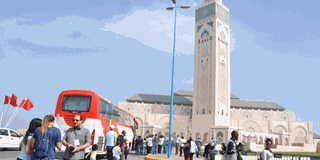Prime
The beauty of Casablanca mosque

Hassan II Mosque in Casablanca Morocco has the tallest minaret. PHOTO BY EMMANUEL AINEBYOONA
What you need to know:
A SIGHT. During an African Press trip in Morocco’s commercial city, Casablanca recently, I had an opportunity to visit the Hassan II Mosque. It hosts the world’s tallest minaret, writes Emmanuel Ainebyoona.
Hassan II Mosque, Casablanca has a rectangular-shaped thin tower called a minaret, which stands at 689feet, dwarfing other buildings that make up the Casablanca skyline. The brownish structure stands in middle-front of the mosque facing other commercial buildings within the city. Currently, it is regarded as the tallest religious structure in the world.
Strategically located near a junction that connects the beach to the other parts of the city, the mosque is easy to access for both the worshipers and visitors to the mosque.
Construction
Built partly on land and partly above sea, the mosque is a sight. Before being ushered into the mosque, every guest was issued a tracking number and a polythene bag to keep their shoes. Muslims enter the holy place for prayers while barefoot.
During the tour of Mosque, our guide Ilhan, told journalists from 28 African countries that construction works were commissioned by King Hassan II on July 12, 1986.
Being a Sunday, the activity happening inside the Mosque was not buzzing apart from a large number of tourists who had come to explore this landmark structure.
Prayer hall
Ilhan says the interior can host about 25,000 worshippers plus about 80,000 people in its external squares. She went on to explain that, “The mosque normally gets full to capacity during Ramadan.” At the less-lit worship area; the mosque has a sliding roof, which normally opens on Fridays and other special prayer days to allow natural sunlight and fresh air given that building is not fitted with air-conditioning.
Building materials include granite, marble, wood, plaster, all from Morocco, except some Italian white granite columns and 56 glass chandeliers. The shiny and smooth marble floor is beautiful and the granite pillars hold the gallery.
“The wood used for carving is the best called cedar from the middle Atlas Mountains, the marble is from Agadir and granite is brought from Tafraoute in Italy,” she said. Ilhan revealed that the Mimbar where the Imam stands and Qibla face the East, a direction to Islam’s holy city of Mecca.
Below the prayer hall are two floors in the basement; a purification area where worshippers get ablution (wash up) before prayers. Water fountains are made of marble.
“From their places of work, people come here to wash before going for their prayers and this is very convenient for them.” she said.
Above the purification area is a social gallery. This section is not part of the mosque but rather a relaxing area for all people, irrespective of their religious affiliations.
Architecture
After the death of his father King Mohammed V in 1961, King Hassan II initiated the idea to construct the mosque. Its design borrows some features from an old Roman fort converted into the tomb of King Mohammed V in Rabat, Morocco’s capital city. It also borrows from the modern-day architectural design as evident in the shape of its green roof.
During his birthday celebrations in 1980, King Hassan II made his ambitions clear for creating a landmark monument in Casablanca stating: “I wish Casablanca to be endowed with a large, fine building of which it can be proud until the end of time ... I want to build this mosque on the water, because God’s throne is on the water.
Therefore, the faithful who go there to pray, to praise the creator on a firm soil, can contemplate God’s sky and ocean.”
Michel Pinseau, a French architect who had lived in Morocco, designed the mosque while construction was by Bouygues, a civil engineering group. The construction was completed in 1993, and lasted seven years despite being earlier scheduled to be completed in 1989.
“During its construction, about 1,400 artisans and craftsmen worked during day whereas another 1,100 worked at night,” Ilhan says. She adds that, the Mosque was inaugurated on the 11th Rabi’ al-awal of the year 1414 of the Hegira, corresponding to August 30, 1993, which also marked the eve of the anniversary of Prophet Muhammad’s birth. The Mosque is said to be the third largest after two mosques in Saudi Arabia.
quick notes
• Compared to Uganda’s landmark mosque located on Kampala Hill in Old Kampala, King Hassan II mosque’s minaret is five times higher than the Uganda National Mosque which stands at 50.5 metres. Also, the Casabalanca mosque is built on nine-hectares of land.
• The Moroccan Kingdom then under King Hassan II is estimated to have spent about Shs22 trillion on its construction costs. The money was raised through public subscription. About 12 million people donated to the cause, with a receipt and certificate given to every donor.
• The Hassan II Mosque is the world’s third-largest mosque, built to commemorate the former king’s 60th birthday.
• Currently, the Kingdom of Morocco is ruled by Mohammed VI who ascended to power in 1999 following the death of his father Hassan II.




